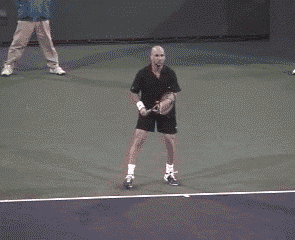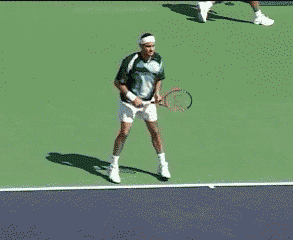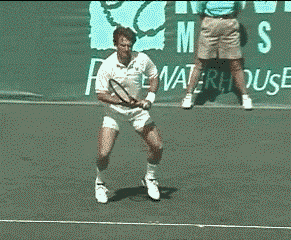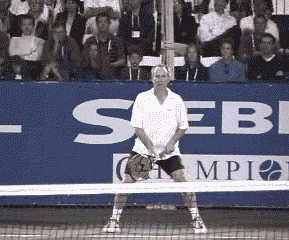| TennisOne Lessons The Opposite Hand on the Forehand CSU Bakersfield Head Coach Dan McCain Most people think that when a right-handed player hits a forehand, the right hand and arm are doing all the work in the stroke. The right hand and arm take the racquet back, the right hand and arm create the swing by dropping the racquet head below the ball and brushing up the back of and through the ball, and then of course, the right hand and arm finish the stroke with a follow-through someplace over the opposite shoulder. And that’s it, right? Well, not quite. All of the above-mentioned pieces of the stroke are vital. But the positioning of the wrist of the dominant hand (within the context of the take-back, swing forward, out and up, and the follow-through) are only half of what top ATP pros have been doing for years. The second (and equally important) foundation of the forehand topspin stroke is shoulder and hip rotation. I tell my students who are still learning the basics of technique that working on their stroke means two things: understanding how to position the wrist throughout the stroke, and understanding how they want to turn their shoulders and hips during the stroke.
And this is true for all strokes, especially the 21st century forehand. Before we delve into why the opposite hand on the forehand is a major foundational element in technique, we first must understand what proper shoulder and hip rotation means. The vast majority of the best forehands on the pro tour today have nearly identical shoulder and hip rotation, and when analyzed closely, Roger Federer and Andre Agassi, for example - and most others - execute their forehands by turning their shoulders and hips 180 degrees. As these players take their racquets back, they all achieve a sideways posture, often with their back shoulder blade visible to their shot targets, facing in a perpendicular stance to where they are aiming their shot. These players all then open up their hips on impacting the ball with grace and elegance, facing their belly buttons directly at where they plan to hit, and then once the follow-through is completed, their chests are facing the opposite direction to which it began. Facing one way (sideways) at the start, facing front upon contact, and facing the other way (sideways opposite) at the end of the stroke. McEnroe and Connors used to the do the same thing, turn the same way. These two legends of the 1970’s had almost identical shoulder and hip rotation as our top pros today possess, the main difference in technique being the absence of a loop as they took the racquet back and a less pronounced follow through than the more modern players of today (where the butt of the racquet faces the sky at the end of the follow-through in an effort to generate more topspin).
By understanding what it means to turn correctly, we can understand not just why the greats of today strike the ball with such ease and effectiveness, but why most top pros throughout the history of the game hit their forehands well. The Role of the Opposite Arm So if the above ideas are understood, and a player wants to always achieve this proper shoulder and hip rotation on all forehands, then a right handed player may consider using the left hand to facilitate this process (and a lefty the right hand). Each of the above-mentioned modern pros (Federer and Agassi) use their left hands with great agility and effectiveness to help them turn on their forehands as they take back their racquets. When preparing for a forehand, their left arms are up and out in front of the body, as if by either pointing the elbow or the palm at the ball as it approaches toward them. The left arm points in the same direction as the sideways chest faces in the beginning of the stroke.
Then, to enhance the hip turning into contact and thereafter, to facilitate the entire rotation, the left arm can be pulled across the body. Dmitri Tursunov, a top 20 ATP pro from Russia, and protege of my former boss (and current ATP Touring Coach), Vitaly Gorin, uses his left arm to enable his shoulder and hip rotation on all forehands – especially when put into difficult or defensive positions. By pulling the left arm across the body after initially pointing his elbow at the ball as it approaches his zone of contact, Dmitri is able to turn completely and correctly throughout his entire stroke with ease. Without an awareness of the opposite arm on the forehand, rotation can be stunted, or abbreviated. By leaving the left arm on or near the torso throughout the entire swing, rotation is often stifled because the left arm is literally in the way and prevents players from turning fully. The opposite hand in this case hangs like a giant dead fish from a player’s body, not moving, and not allowing anything else to move. By not turning properly, contact points and wrist positioning will often be compromised, and so will accuracy and power. Additionally, one is far better off, when preparing for a forehand, to keep the left arm either straight or slightly bent, with the elbow pointing relatively upward. If the arm is bent and the elbow is pointed downward, creating a V-shape with the arm and elbow, shoulder and hip rotation can also be negatively affected. With the elbow pointed down, the left arm can inhibit rotation. On the other hand, with the elbow facing straight at the ball or even upward, a player can more easily pull his left arm/hand across the body and therefore turn more completely.
For beginners, I have my pupils using their opposite hands without them knowing it. After they literally point with their finger at the ball as it approaches them, I tell them to catch their racquet once their follow through has finished. This idea of catching the racquet after the follow through is really not advisable for advanced players who wish to vary their levels of acceleration a great deal. Catching can shorten a follow through and unintentionally inhibit acceleration. But if the student is made aware that catching the follow through is only a temporary method of creating an awareness for them as to how to use the left arm (or how to get it out of the way) to enable good rotation, they will begin to understand quickly what they need to do. Catching used in this way (as a temporary method) can be useful in these isolated circumstances. More advanced players exposed to this information for the first time tend to catch on to the idea of pointing their opposite hand’s elbow at the ball as it approaches, or pointing their opposite hand’s palm at the ball, before they pull their opposite arm across their bodies to help them turn more effectively. So the next time you’re thinking about how to turn on your forehand, take a tip from the pros and think about how your opposite hand and arm can help you. Try pointing your elbow or palm at the ball as it flies though the air toward you then pull your non-dominant hand across your body. It could make the difference between an ordinary forehand and something else, a real weapon. |



